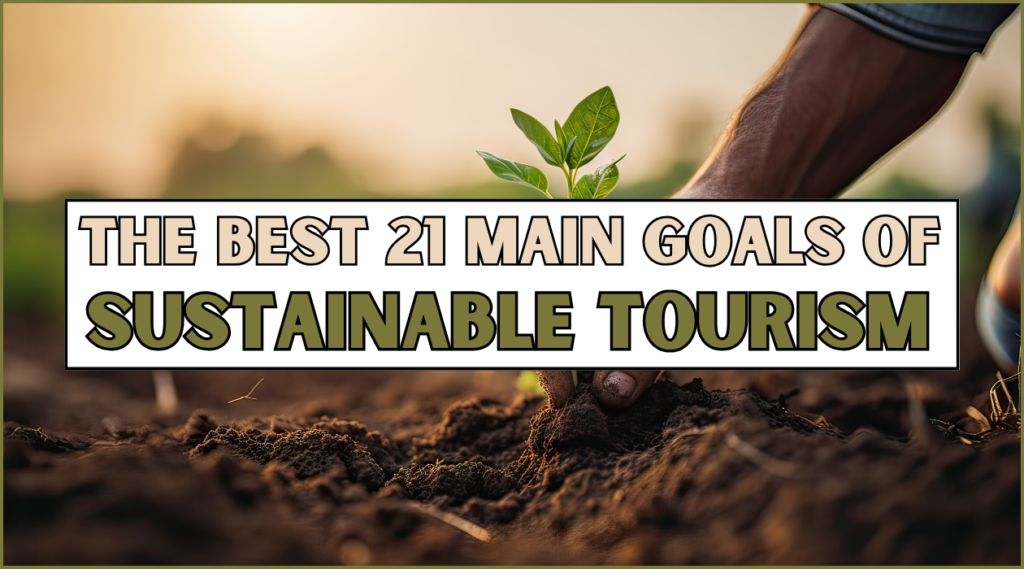Key Objectives of Sustainable Tourism: Top 21 Goals
Sustainable tourism is a holistic approach to travel that seeks to minimize negative impacts on the environment, society, and economy while maximizing positive contributions. The primary aim is to create a balance where tourism can be enjoyed today without compromising the ability of future generations to enjoy the same experience. Here are the best 21 main goals of sustainable tourism, each crucial for fostering a more responsible and enriching travel industry.
1. Environmental Conservation

One of the cornerstone goals of sustainable tourism is the conservation of the environment. This includes preserving natural habitats, protecting endangered species, and minimizing pollution. Sustainable tourism advocates for practices such as eco-friendly accommodations, waste reduction, and promoting awareness about environmental issues among tourists. By prioritizing conservation, tourism can help protect the planet’s biodiversity and ensure that natural attractions remain pristine for future generations.
2. Cultural Preservation

Cultural preservation is essential in sustainable tourism, aiming to protect and promote the heritage, traditions, and lifestyles of local communities. This involves respecting and valuing the customs, languages, and artistic expressions of the places tourists visit. Sustainable tourism encourages the participation of local people in tourism activities, ensuring that their cultural identity is celebrated and not commodified. By fostering cultural understanding and appreciation, sustainable tourism helps maintain the unique character of destinations.
3. Economic Development
Sustainable tourism aims to contribute to the economic well-being of local communities. This goal focuses on creating jobs, supporting local businesses, and ensuring that tourism revenue benefits the local economy. Sustainable tourism promotes fair wages, equitable working conditions, and opportunities for economic growth that do not exploit people or resources. By prioritizing economic development, sustainable tourism can alleviate poverty and improve the quality of life for local residents.
4. Community Empowerment
Empowering local communities is a fundamental goal of sustainable tourism. This involves giving residents a voice in tourism planning and decision-making processes. Community empowerment ensures that tourism development aligns with the needs and aspirations of local people. It encourages capacity building, education, and the creation of platforms where communities can share their stories and expertise. When communities are empowered, they can take ownership of tourism initiatives and ensure that these activities are sustainable and beneficial.
5. Responsible Resource Use
Sustainable tourism promotes the responsible use of natural resources, emphasizing the importance of reducing, reusing, and recycling. This goal addresses the efficient management of water, energy, and materials to minimize waste and reduce the ecological footprint of tourism activities. By adopting sustainable practices such as renewable energy sources, water conservation measures, and eco-friendly materials, the tourism industry can significantly reduce its impact on the environment.
6. Minimizing Carbon Footprint

Reducing the carbon footprint of tourism is crucial for mitigating climate change. Sustainable tourism encourages the use of low-carbon transportation options, such as biking, walking, and public transit. It also promotes energy-efficient accommodations and the adoption of green technologies. By raising awareness about the environmental impact of travel and promoting carbon offset programs, sustainable tourism aims to minimize greenhouse gas emissions and contribute to global climate goals.
7. Education and Awareness
Educating tourists and industry stakeholders about the principles and practices of sustainable tourism is vital for its success. This goal involves providing information about the environmental, cultural, and economic impacts of tourism and promoting responsible behavior. Educational initiatives can include interpretive programs, workshops, and the dissemination of information through various media. By raising awareness, sustainable tourism fosters a more informed and conscientious traveler community.
8. Promoting Inclusivity
Inclusivity is a key goal of sustainable tourism, ensuring that tourism activities are accessible and beneficial to all segments of society. This includes creating opportunities for marginalized groups, such as women, Indigenous peoples, and people with disabilities. Sustainable tourism advocates for inclusive policies and practices that promote diversity and equity. By prioritizing inclusivity, tourism can become a tool for social justice and empowerment.
9. Enhancing Visitor Experience

A positive visitor experience is essential for the success of sustainable tourism. This goal focuses on creating meaningful and enjoyable travel experiences that foster a deep connection with the destination. Sustainable tourism emphasizes authenticity, quality, and a sense of place, encouraging tourists to engage with local culture and nature. By enhancing the visitor experience, sustainable tourism can promote repeat visits and positive word-of-mouth, benefiting both tourists and host communities.
10. Protecting Human Rights
Respecting and protecting human rights is a fundamental aspect of sustainable tourism. This goal involves ensuring that tourism activities do not contribute to exploitation, discrimination, or abuse. Sustainable tourism promotes ethical practices, such as fair labor conditions, gender equality, and the protection of children. By advocating for human rights, sustainable tourism can create a more just and equitable industry.
11. Supporting Sustainable Development Goals
Sustainable tourism aligns with the broader framework of the United Nations Sustainable Development Goals (SDGs). These goals address global challenges such as poverty, inequality, and environmental degradation. Sustainable tourism contributes to several SDGs, including those related to economic growth, responsible consumption, and climate action. By supporting the SDGs, sustainable tourism can play a significant role in achieving a sustainable future.
12. Building Resilience
Building resilience in tourism destinations is crucial for adapting to environmental, social, and economic changes. This goal involves developing strategies to cope with challenges such as climate change, natural disasters, and economic fluctuations. Sustainable tourism promotes adaptive management, disaster preparedness, and community-based approaches to resilience. By building resilience, tourism destinations can withstand and recover from adverse events, ensuring long-term sustainability.
13. Sustainable Tourism
Sustainable tourism is more than just a trend; it is a necessity for the future of travel. By focusing on environmental conservation, cultural preservation, and economic development, sustainable tourism aims to create a harmonious relationship between tourists and destinations. This approach not only enhances the quality of life for local communities but also provides enriching experiences for travelers. Sustainable tourism requires the collaboration of governments, businesses, communities, and tourists to achieve its goals.
14. Environmental Initiatives
Implementing environmental initiatives is a practical step toward achieving the goals of sustainable tourism. These initiatives can include reforestation projects, wildlife conservation programs, and efforts to reduce plastic waste. Environmental initiatives demonstrate a commitment to protecting natural resources and promoting biodiversity. By supporting and participating in these initiatives, the tourism industry can make a tangible difference in preserving the planet.
15. Cultural Exchange Programs
Cultural exchange programs are an effective way to promote understanding and appreciation between tourists and local communities. These programs can include homestays, cultural workshops, and volunteer opportunities. By engaging in cultural exchange, tourists gain a deeper insight into local traditions and lifestyles, while communities benefit from increased awareness and respect for their culture. Sustainable tourism encourages such exchanges to foster mutual respect and learning.
16. Economic Opportunities for Women
Empowering women through economic opportunities is a vital component of sustainable tourism. This goal involves creating jobs, supporting female entrepreneurs, and promoting gender equality in the tourism industry. By providing women with the tools and resources to succeed, sustainable tourism can contribute to greater economic stability and social equity. Initiatives such as women-led tours, craft cooperatives, and leadership training are examples of how tourism can support women’s empowerment.
17. Youth Engagement
Engaging youth in sustainable tourism is essential for fostering a future generation of responsible travelers and industry leaders. This goal focuses on providing educational opportunities, internships, and mentorship programs for young people. By involving youth in sustainable tourism initiatives, the industry can benefit from fresh perspectives and innovative ideas. Youth engagement also helps build a culture of sustainability that can be passed on to future generations.
18. Responsible Marketing
Responsible marketing is crucial for promoting sustainable tourism practices. This goal involves creating honest and transparent marketing campaigns that highlight the importance of sustainability. Responsible marketing avoids greenwashing and ensures that tourism products and services are genuinely eco-friendly and socially responsible. By promoting sustainable options, the tourism industry can influence consumer behavior and drive demand for responsible travel experiences.
19. Partnerships and Collaboration
Collaboration between various stakeholders is essential for achieving the goals of sustainable tourism. This includes partnerships between governments, businesses, non-governmental organizations, and local communities. By working together, stakeholders can share knowledge, resources, and best practices to promote sustainability. Collaborative efforts can lead to more effective and comprehensive solutions to the challenges facing the tourism industry.
20. Technological Innovation
Embracing technological innovation can significantly enhance the sustainability of tourism. This goal involves adopting technologies that reduce environmental impact, improve efficiency, and enhance the visitor experience. Innovations such as digital ticketing, virtual tours, and smart tourism platforms can contribute to more sustainable practices. By staying at the forefront of technological advancements, the tourism industry can continue to evolve and meet the demands of a changing world.
21. Monitoring and Evaluation
Regular monitoring and evaluation are crucial for assessing the effectiveness of sustainable tourism initiatives. This goal involves tracking progress, identifying challenges, and making necessary adjustments to strategies and practices. Sustainable tourism requires a commitment to continuous improvement and adaptive management. By setting clear goals and metrics, the industry can ensure that it is moving toward greater sustainability.
FAQs For Main Goals of Sustainable Tourism
What is the primary goal of sustainable tourism?
The primary goal of sustainable tourism is to minimize negative impacts on the environment, society, and economy while maximizing positive contributions. This ensures that tourism can be enjoyed today without compromising the ability of future generations to enjoy the same experience.
How does sustainable tourism benefit local communities?
Sustainable tourism benefits local communities by creating jobs, supporting local businesses, and ensuring that tourism revenue stays within the community. It also promotes cultural preservation and empowers local residents by involving them in tourism planning and decision-making processes.
What are some examples of sustainable tourism practices?
Examples of sustainable tourism practices include using eco-friendly accommodations, reducing waste and pollution, promoting cultural exchange programs, supporting local businesses, and adopting low-carbon transportation options.



